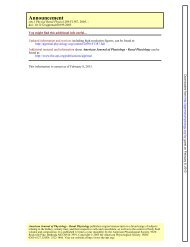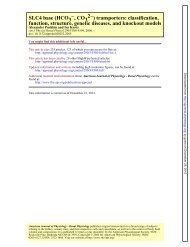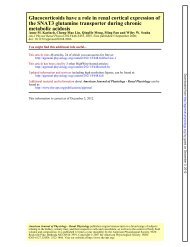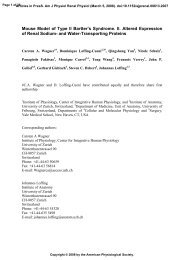Increased susceptibility of aging kidney to ... - Renal Physiology
Increased susceptibility of aging kidney to ... - Renal Physiology
Increased susceptibility of aging kidney to ... - Renal Physiology
You also want an ePaper? Increase the reach of your titles
YUMPU automatically turns print PDFs into web optimized ePapers that Google loves.
damage) in<strong>to</strong> the culture media. There were no significant<br />
differences in ATP and GSH content in control slices from<br />
young, aged-AL, and age-CR rats at either 30 or 60 min, or for<br />
LDH and �GST leakage in<strong>to</strong> the media (Table 1). There was<br />
an increased <strong>susceptibility</strong> <strong>to</strong> ischemic injury in aged-AL rats<br />
compared with young counterparts, as assessed by intracellular<br />
ATP and leakage <strong>of</strong> LDH and �GST following either 30 or 60<br />
min <strong>of</strong> simulated ischemic injury (Fig. 2A). While there was<br />
significant difference between aged-CR and young at 60 min<br />
with respect <strong>to</strong> LDH and �GST, CR significantly attenuated<br />
the loss <strong>of</strong> viability seen in aged-AL slices for all parameters,<br />
at both 30 and 60 min. Although intracellular GSH was a less<br />
sensitive indica<strong>to</strong>r <strong>of</strong> the loss <strong>of</strong> viability, there was still a<br />
significant difference between young and aged-AL after 60 min<br />
<strong>of</strong> simulated ischemia (Fig. 2A).<br />
His<strong>to</strong>logical evaluation <strong>of</strong> the tissue following 60 min <strong>of</strong><br />
simulated ischemia demonstrated significant tubular damage in<br />
slices harvested from aged-AL rat (i.e., flattened tubular epithelium,<br />
cell vacuolization, and sloughing and loss <strong>of</strong> eosin<br />
staining) while relatively little tubular damage was seen in<br />
young and aged-CR samples (Fig. 2B). Taken <strong>to</strong>gether, these<br />
results demonstrate that 1) <strong>susceptibility</strong> <strong>to</strong> injury increases<br />
with age, and can be attenuated by CR, and 2) the increased<br />
injury response is, in part, intrinsic <strong>to</strong> the <strong>kidney</strong>.<br />
Microarray analysis and validation. In an effort <strong>to</strong> identify<br />
the molecular mechanisms mediating the increased suscepti-<br />
AGING KIDNEY AND ISCHEMIC INJURY<br />
bility <strong>to</strong> injury in the <strong>aging</strong> <strong>kidney</strong>, microarray analysis was<br />
performed. The data were analyzed as described in METHODS<br />
and filtered <strong>to</strong> identify genes changed by <strong>aging</strong>, CR, or <strong>aging</strong><br />
and attenuated by CR (Fig. 1). Complete lists <strong>of</strong> genes changed<br />
by <strong>aging</strong> (1,325 genes), CR (790 genes), age-induced changes<br />
potentiated by CR (2 genes), and age-induced changes attenuated<br />
by CR (92 genes) are shown in the online version <strong>of</strong> this<br />
article as it contains the supplemental data.<br />
Based on the injury data, we focused on the group <strong>of</strong> genes<br />
that was changed by <strong>aging</strong>, but attenuated by CR. The wellannotated<br />
genes (named genes) downregulated by age but<br />
corrected by CR and upregulated by age but corrected by CR<br />
are shown in Tables 2 and 3, respectively. Several upregulated<br />
genes were also further pursued, including claudin-7, an integral<br />
membrane protein <strong>of</strong> tight junctions, Kim-1, a putative<br />
epithelial adhesion molecule that is upregulated following<br />
injury (14) and thought <strong>to</strong> be a promising biomarker for renal<br />
injury (13, 15), and MMP-7 (matrilysin) (Fig. 3A). The expression<br />
changes in these genes <strong>of</strong> interest were confirmed by<br />
quantitative PCR. Similar <strong>to</strong> the microarray data, the expression<br />
<strong>of</strong> claudin-7, Kim-1, and MMP-7 was increased during<br />
<strong>aging</strong>, but attenuated by CR (Fig. 3B).<br />
Investigation in<strong>to</strong> the time course <strong>of</strong> changes in claudin-7<br />
revealed that gene expression was increased significantly at 18<br />
mo, but not at 24 mo (Fig. 4A). Interestingly, protein expression<br />
was increased at 24 mo as assessed by Western blot (Fig.<br />
Fig. 6. Impact <strong>of</strong> <strong>aging</strong> on MMP-7 expression. A: MMP-7 gene expression was assessed using quantitative PCR; the �-actin-normalized MMP-7 gene expression<br />
is presented relative <strong>to</strong> the gene expression in an arbitrary reference sample (Stratagene Rat Universal Reference RNA). The values represent means � SD <strong>of</strong><br />
relative gene expression <strong>of</strong> 4 animals per group. *Significant difference in 24-mo AL compared with young. **Significant difference in aged-AL compared with<br />
young and aged-CR. B: Western blot analysis <strong>of</strong> MMP-7 protein levels in <strong>kidney</strong> lysates. Full-length MMP-7 is seen at �27 kDa; membranes were stripped and<br />
reprobed with an antibody against �-actin <strong>to</strong> demonstrate equal loading. C: paraffin-embedded sections were processed for immunohis<strong>to</strong>chemical localization<br />
<strong>of</strong> MMP-7 with a commercially available system; similar results were seen in duplicate experiments.<br />
AJP-<strong>Renal</strong> Physiol • VOL 293 • OCTOBER 2007 • www.ajprenal.org<br />
F1279<br />
Downloaded from<br />
http://ajprenal.physiology.org/<br />
by guest on December 6, 2012








